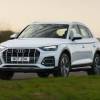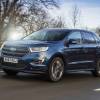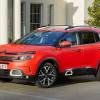
RAC sale – up to 33% off*
• Roadside cover from £5.29 a month†
• We get to most breakdowns in 60 mins or less
• Our patrols fix 4/5 breakdowns on the spot

By Andy Enright
Introduction
The Jeep Cherokee is a car that never quite made a seamless translation into British automotive culture. For about five minutes back in the mid Eighties it was fashionable, but since then it has been outsold by more sophisticated rivals from both Europe and Asia. Sophisticated only gets you so far when you're up to your axles in mud, though, and one group that Jeep has had no problem selling to are those who actually use the vehicles as Jeep's designers intended. The third generation Cherokee we examine here was a short-lived thing but used examples are around if you're prepared to put in the legwork.
Models
5 dr compact 4x4 (2.8 diesel [Limited])
History
The original XJ-series Jeep Cherokee imported to the UK was that squared off vehicle with the fake wood interior that was small just as every other 'compact' 4x4 got big. Its replacement (the KJ) was an altogether curvier thing and its styling appealed to ladies who were then rather crestfallen by the fact they needed a sports bra and ear protection to drive it. The third generation (KK) Jeep Cherokee is by far the best but it didn't hang around for long, its 2.8-litre diesel engine getting the red card from the burghers in Brussels due to its poor emissions record. Shame. Jeep looked like getting the formula just right after 26 years of trying.
What You Get
The bluff front end with its square headlamps and the steroidal wheel arches are distinctly reminiscent of the Dodge Nitro and the similarity is not accidental, the two cars running on a common platform. The Cherokee is a degree bigger than its predecessor, with a wheelbase that's around 50mm longer and the wheels have been pushed wider by some 25mm front and rear. It's also lower by around 75mm but the load height of the luggage bay is higher by the same amount. Jeep compensates by extending the length of the cargo bay by 75mm. It's still not that big for full-sized rear seat occupants but makes use of its space more intelligently.
Build quality can best be described as functional. The American domestic market doesn't seem to place too much store on materials quality and the Cherokee feels built down to a price. On the plus side, it's very rugged and you don't have to look at the manual to figure out how the controls work. The feel is a good deal more masculine than that of its rather rounded predecessor, a car that gained 60 per cent of its sales from women. This time round the target demographic was a little more hairy of chest.
What You Pay
Please fill in the form here for an exact up-to-date information.
What to Look For
The mechanicals of Jeep Cherokees are astonishingly tough. The parts that have been known to play up are the electronics so check that all of the lighting and control systems are working as they ought to. This may entail taking the vehicle off road. It sounds obvious, but if you're planning to use the vehicle off road, the pre-sale test needs to include off-road driving.
Replacement Parts
(approx based on a 2009 Cherokee 2.8 CRD Limited) A clutch assembly is around £400. Front brake pads are around £40, a full exhaust about £700 (with the catalyst) and an alternator around £300.
On the Road
Only one engine was ever offered to UK buyers but it was the most relevant one available to Jeep, a 174bhp 2.8-litre four-cylinder diesel. It's not the most refined powerplant in the world but it suits the rugged feel of the Cherokee very well and leaves you under no illusions that this is a vehicle that's not been designed purely to perambulate outside city centre shopping arcades. The live rear axle is also another reminder that the Cherokee chooses tough over fancy. While the ride on road isn't as composed as something like a Honda CR-V's or even a Land Rover Freelander's, the Jeep feels better able to withstand some abuse than both.
With decent ground clearance and a proper low range transfer box, Hill Descent Control (with the automatic gearbox option) and a revised Selec-Trac II four-wheel-drive system which helps anticipate and prevent wheel slip before it occurs (making it ideal for road driving and towing), the Cherokee is well equipped for off-road work. The hill descent system is interesting in the way it operates. A tilt switch detects whether the car is on a slope and HDC will only cut in if an incline is detected, preventing the frustrating lurching that many such systems generate as soon as you try to accelerate across a short flat section. If the car is pointing uphill, HDC will even operate in reverse. A fuel economy figure of 32.8mpg isn't at all bad for a vehicle of this size and power.
Overall
The Jeep Cherokee is a car that came good right at the end of its life. It was still not as plush inside as the best of its rivals but its combination of rugged styling, affordable pricing and go-anywhere capability made it a sound recommendation for anybody who needed a car that could do the true road and trail combination but didn't want to fork out for a Freelander. The only real fly in the ointment was the frankly terrible 228g/km carbon dioxide emissions which ultimately proved its downfall.
If you're looking for a used example, try to find one that has been bought as a bauble and never been subjected to anything more arduous than a drop kerb outside Dorothy Perkins. Then point it at the nearest muddy track and prepare to be amazed Huge fun, huge capability and a modest asking price? There's life in this formula yet.

![Jeep Cherokee [KK] (2008-2013) used car review](https://d1ix0byejyn2u7.cloudfront.net/drive/images/made/drive/images/remote/https_d2yv47kjv2gmpz.cloudfront.net/filestore/4/0/7/1_8858c2b0ff32e2e/bdd7386b5690e5830a9216cdff45d1d9/1704_dd6b66bb90c2af0_794_529_70.jpg)





